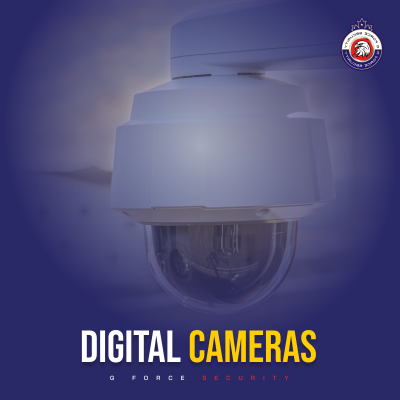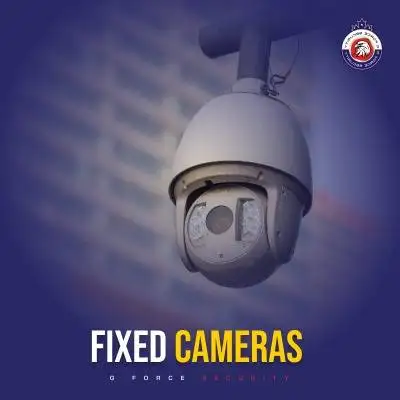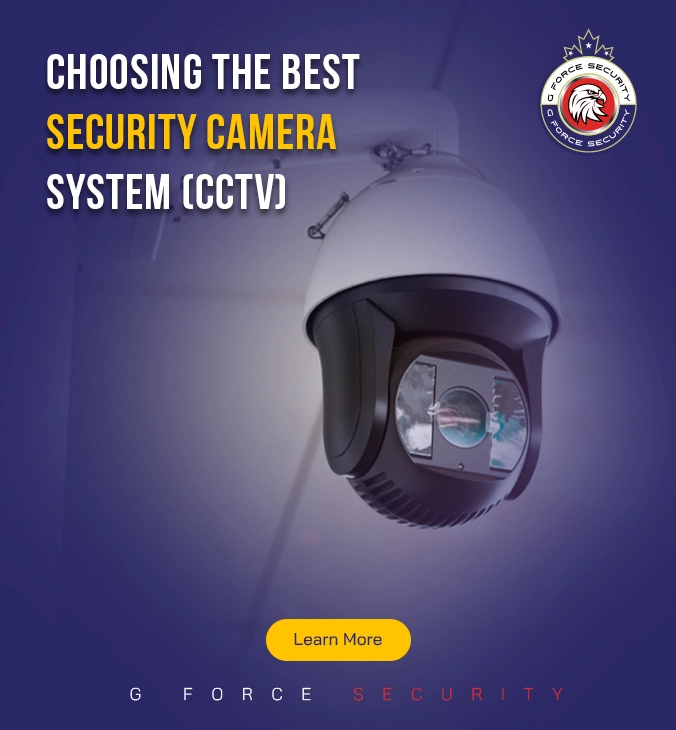Choosing the Best Security Camera System (CCTV) (2024)
In the era of increasing smart home adoption in Canada, security cameras & video surveillance systems have become crucial for safeguarding homes and businesses. These cameras play a vital role in deterring criminal activities, providing documentation in case of incidents, and enabling remote monitoring through smartphones. However, choosing the right & best security camera system can be a bit daunting, as it requires thorough assessment and technical know-how.
How effective is the Video surveillance system?
A Toronto Police Service report highlighted theft in areas where security cameras were installed, there was a noticeable decrease in crime rates and roughly 20% decrease in property-related crimes in the monitored areas. Moreover, 85% of burglars admitted that visible security cameras influenced their decision to avoid certain properties, revealed a Vancouver Police Department survey.
Beyond their role in monitoring and recording, the presence of security cameras is a powerful deterrent, making them an indispensable asset in both residential and commercial security systems.
Understanding Home Security Cameras
What are Home security Cameras?
Security cameras system monitor and record activities for enhanced safety, deter intruders, crime, provide real-time monitoring, and ensure overall security, hence playing a vital role in keeping homes and businesses safe. The rising popularity of these devices is driven by affordable prices & user-friendly features. With advances like motion detection, and integration of advanced technologies like AI and machine learning in modern camera systems has further enhanced their effectiveness, enabling real-time analysis and prompt response to potential threats to homes and businesses.
Necessity of Home & Commercial Security Cameras
Security cameras are super-important for homes and businesses; works like a warning sign, scaring away bad guys and making places safer. They become more resilient when accompanied by a professional alarm monitoring system. These cameras let you check what’s happening from the smartphone, which is really handy. If something bad does happen, like a break-in, the recorded videos can help the police as a proof to catch suspect. Having security cameras can even lower the insurance costs because it shows you’re serious about your safety for your business.
According to a report by the Urban Institute, public surveillance cameras in Baltimore, Maryland, contributed to a significant reduction in crime, with incidents in areas under surveillance dropping by an average of 30%.
A study by the University of North Carolina at Charlotte’s Department of Criminal Justice and Criminology found that about 60% of convicted burglars stated the presence of a security camera system influenced their decision to target another home.
Determining Security Needs & Budget for CCTV Cameras
Assess your Security Needs
Choosing the right level of protection for a security camera system depends on various factors. For basic security, simple CCTV systems with standard cameras and essential features like motion detection work well for homes or low-risk areas.
On the other hand, more complex or high-risk settings, like businesses, warehouses, factories, corporate event security with high profile attendees or critical infrastructure, may require advanced surveillance systems. Advanced setups come with features like facial recognition, night vision, and real-time monitoring analytics, providing a heightened level of security for business.
Budget
When establishing a budget, it’s essential to carefully consider specific requirements & priorities of the intended surveillance. Factors influencing the budget include the number of cameras needed, the desired features such as high-resolution imaging or advanced analytics, and the quality of the equipment.
Types of Security Camera Systems
There are array of security cameras for homes, apartments & commercial surveillance to choose from in Canada.

Below are discussed some of the best security Camera types that are being used commonly.
Analog Cameras
Analog cameras are traditional surveillance cameras that capture and transmit video signals in a physical format & signals are sent over coaxial cable to digital video recorder. These cameras have been widely used in various security applications, including residential, commercial, construction sites and industrial places.

Analog monitoring cameras typically have a lower resolution compared to digital cameras, with standard resolutions ranging from 480p to 720p. This level of resolution meets the requirements of basic surveillance but may not provide enough detail for more sophisticated security needs.
Digital Cameras
Digital cameras, (also known as IP cameras) are profusely used in security camera systems and have become increasingly popular due to their advanced features, improved image quality, remote handling, and enhanced functionality. They enhance surveillance capabilities, offer clearer identification of subjects, and enable efficient monitoring and management of security environments.

Digital monitoring cameras offer higher resolutions than analog cameras, starting from 1080p and going up to 4K or higher. Further they can be connected to a network, allowing them to transmit data over the internet or a local network. Digital cameras are more costly then Analog cameras and usually require robust cyber security measures to prevent unauthorized access.
Wireless Cameras
Wireless cameras, also known as Wi-Fi cameras, offer unparalleled flexibility and ease of installation. A standout feature of wireless cameras is their capacity for remote monitoring through Wi-Fi connectivity.

This advantage makes wireless cameras a more valuable and convenient choice for Canadians who’re looking for efficient and customizable security solutions. Wireless Cameras can be battery-powered or plugged into a power source. Battery-powered models offer greater flexibility in placement but require regular battery changes or recharging.
Wired Cameras
Wired cameras (known for reliability and consistency) are a foundational component of security camera systems, relying on physical cables for both power and data transmission.

These cameras play a crucial role in security systems by offering a reliable and secure surveillance solution. They are especially useful in places where using physical wires for connections is preferred or necessary. This wired setup ensures a stable and continuous video feed, making these cameras a dependable choice for security needs in various environments.
Video Doorbells
Video doorbells offer real-time monitoring and communication at entry points. They allow homeowners to see and communicate with whoever is at their door, whether it’s a visitor, a delivery person, or an unexpected caller.

Many models of Video door bell come with remote viewing through smart phone apps.
In a theft or break-in attempt, the recorded footage can also serve as valuable evidence for local law enforcement agencies.
They are easy to install & maintenance includes software updates, timely battery charges & replacements.
Fixed Cameras
Fixed cameras (also known as static cameras) are stationary surveillance devices where cameras remain in a fixed position, capturing a specific area without the ability to pan or tilt (Unlike PTZ -Pan-Tilt-Zoom). They provide continuous surveillance with simplicity and reliability of specific areas such as building entrances, parking lots, or hallways.

Fixed cameras come with various lens types, such as wide-angle or telephoto, to suit different monitoring needs. The choice of lens determines the width and detail of the area covered.
Since they only cover a fixed area, blind spots can be an issue. Moreover, like PTZ cameras, they cannot be remotely adjusted to follow moving objects or change the viewing angle.
Dome Cameras
Dome cameras (enclosed in a transparent, dome-shaped cover) with their rounded shape, are versatile and discreet in security systems, suitable for indoor and outdoor monitoring.

They offer a wide view, and their protective design conceals the camera’s direction, enhancing security. Dome cameras are valuable for effective surveillance in various settings, at home, apartments and in businesses.
Dome cameras can be either fixed or have PTZ (Pan-Tilt-Zoom) capabilities, come in both digital and analog and can be used indoors or outdoors.
Bullet Cameras
Bullet cameras, with their distinctive, small, bullet shell or lipstick case shape. These cameras come with fixed or varifocal lenses.

They are designed to focus on specific areas such as entry points or perimeters with a narrow field of view, and their durable design withstands various weather conditions, hence a popular choice for outdoor surveillance. Their presence is often noticeable, which can be a deterrent to potential intruders.
Day/Night Cameras
Day/night cameras are able to capture clear video in different lighting conditions & can smoothly switch between day and night modes.

Using advanced technology & they have an edge over regular cameras which may not perform well under low-light conditions.
During the day they function like regular video cameras. Capturing footage in full color and switching to black & white mode in night or low light conditions.
Hidden Cameras
Hidden cameras, also known as spy cameras, are discreet surveillance devices designed to blend seamlessly into their surroundings. These cameras are often small and inconspicuous, making them ideal for covert monitoring in various settings.

The role of hidden cameras in security systems is to discreetly monitor areas without alerting individuals to their presence. Hidden cameras are valuable tools for investigations and can be used in both commercial and residential settings to enhance security.
It is imperative to consider the legal and ethical implications of their use. But their deployment should always respect privacy laws in Canada and personal boundaries.
Indoor Cameras
Indoor cameras are specialized surveillance devices designed for monitoring activities within enclosed spaces such as homes, offices, or retail stores security.

They provide focused surveillance within enclosed spaces, offering protection against unauthorized access, theft, or other security concerns.
Indoor CCTV cameras can be wired, wireless, Pan-Tilt Zoom, night vision etc., depending on the site structure and security needs. Hiring a professional CCTV installation security agency in Canada to get a need assessment and installation, is a wise proposition.
Outdoor Cameras
Outdoor cameras are essential for security systems, keeping a watchful eye on the outside areas of homes and businesses.

These cameras play a key role in deterring potential intruders and capturing clear footage of any suspicious activities, contributing to overall security. Moreover they create an additional layer of security, helping to prevent break-ins and vandalism.
Determining Security Needs and Budget for CCTV Installation
Security Needs
Choosing the best level of protection for a security camera system depends on the environment’s needs.
For basic security, simple systems with standard cameras and essential features like motion detection work well for homes or low-risk areas. On the other hand, more complex or high-risk settings, like businesses, retail stores, Government organizations can benefit from advanced systems. Advanced setups come with features like facial recognition, night vision, and real-time monitoring analytics, providing a heightened level of security.
Assessment phase can be tricky; consider consulting with a professional CCTV monitoring & installation agency in Canada for a comprehensive risk assessment.
>>>>>>> Get Free Site Survey & Assessment under 30 minutes here
Budget
While determining a budget for the best security camera systems, it’s essential to carefully consider the specific requirements & priorities of the intended surveillance. Factors influencing the budget include the number of cameras needed, the desired features such as high-resolution imaging or advanced analytics, and the quality of the equipment.
Camera Placement and Installation Tips
Strategic locations for Camera Placement
Strategic placement of cameras is paramount in optimizing the effectiveness of a security camera system. To maximize coverage and capture critical details, cameras should be strategically positioned at key entry points such as doors and windows. Additionally, ensuring cameras cover vulnerable areas like parking lots, alleys, and blind spots.
DIY (Do It Yourself) vs. Professional Camera Installation Options
Deciding whether to install your CCTV security system yourself or hire professionals depends on your technical skills & personal preferences. If you’re tech-savvy and like hands-on projects, a do-it-yourself (DIY) approach could be a good fit. However, if you prefer a hassle-free setup or lack of technical information. Choosing a professional CCTV installation services in Canada might be a better option. Regardless of the installation method, it’s crucial to understand the basics of maintaining your CCTV security camera system to ensure it works effectively over the long term.
Legal Considerations in Canada for Camera Placement
In Canada, placing surveillance cameras comes with legal responsibilities to protect privacy. Generally, individuals and businesses are allowed to use surveillance cameras on their property, but there are limitations. It’s crucial to follow CCTV monitoring privacy laws.
- Avoid pointing cameras at private areas like bedrooms, bathrooms, or places where people expect privacy.
- Consent is a crucial factor, and is required when capturing images or recordings of individuals.
- Signs indicating the presence of surveillance may be necessary to inform people that they are being monitored.
- Compliance with local, provincial, and federal privacy laws is essential to avoid legal issues related to CCTV placement in Canada.
Connectivity and Power Options
CCTV systems offer various connectivity and power options, each catering to specific needs and environments.
Wired vs. Wireless Camera Systems: Pros and cons
Choosing between wired and wireless security camera systems involves considering their respective pros and cons.
- Wired cameras systems offer a reliable connection with stable video transmission and enhanced security against hacking. Their installation, though, might be trickier.
- Wireless Camera systems, on the other hand, are easier to install and provide flexibility in camera placement, making them suitable for various scenarios. Yet, they may face signal disruptions and potential cybersecurity risks.
- Deciding between the two depends on factors like reliability, installation complexity, and security concerns, ensuring the chosen system aligns with your specific needs and preferences.
Power Options: Battery-Operated vs. Plugged in Cameras
When it comes to powering security camera systems, the choice between battery-operated and plugged-in options has some important considerations.
- Battery-operated cameras offer flexibility in placement but require regular recharging. They’re handy where wiring is challenging.
- On the flip side, plugged-in cameras provide a continuous power supply without the need for battery management, ensuring reliability.
- Deciding between the two depends on factors like convenience, maintenance preferences, and the specific installation environment.
Video Quality, Storage, and Viewing Angle
Understanding Video Resolution: 1080p, 4K etc.
Choosing the best security camera system involves understanding video resolution, like 1080p or 4K. Higher resolutions provide sharper images for better identification, but they require more storage space. For broader coverage, 4K cameras may be beneficial, while 1080p cameras offers a balance between image quality and storage efficiency, suitable for various security needs.
Storage Options: Cloud vs. Local Storage
Cloud storage allows remote access from anywhere with an internet connection. Understanding the importance of viewing angle and area coverage is vital. It eliminates on-site storage concerns but may involve ongoing costs.
Local storage saves footage directly to on-site devices like hard drives or network video recorders (NVRs). While it provides control over data and may be cost-effective. There is a risk of loss of data if the device is compromised.
Importance of Viewing Angle and Area Coverage
The viewing angle determines the extent of the camera’s field of vision, influencing the coverage area. Finding the right balance between a camera’s viewing angle and coverage ensures effective monitoring, minimizing blind spots, and optimizing security. This enhances the system’s overall effectiveness in capturing important details and maintaining attentive surveillance.
Smart Home Integration and Advanced Features
Integration With Smart Home Systems
Integrating security camera systems with smart home platforms such as Google Nest or Amazon Alexa enhances the overall functionality and security of home & commercial surveillance & monitoring. Integration allows users to control & monitor their security cameras through voice commands or mobile apps. Providing seamless access and management for their home and businesses. It not only adds a layer of convenience. But also enhances the user’s ability to manage and customize their home security experience. Compatibility with these popular smart home systems also ensures future scalability.
Advanced Features: AI, Activity Zones, and Geofencing
Incorporating advanced features like artificial intelligence (AI), activity zones, and geofencing significantly enhances the capabilities of security camera systems.
AI enables cameras to smartly recognize and differentiate objects and activities, providing more precise and targeted alerts. With activity zones, users can define specific areas within the camera’s view for focused monitoring.
Geofencing adds an extra layer of sophistication by using the location of the user’s mobile device to automatically adjust camera settings or trigger specific actions based on their proximity.
Final Recommendations
Choosing the best security camera system in Canada involves considering key factors such as resolution, night vision, remote access, and budget. Assessing specific needs, ease of installation, and compliance with legal regulations is essential. By prioritizing these aspects, individuals and businesses can make informed decisions to ensure an effective and tailored monitoring solutions.
G Force Security stands out as a reliable choice for both home and business surveillance & monitoring needs, offering a combination of affordability, modern features & tailored solutions. G Force Security provides a trusted and efficient option for those seeking a reliable and advanced CCTV security camera system installation in Ontario & across Canada
Contact G-Force Security at (905)-519-0101 or www.gforcesecurity.ca for a free site evaluation and competitive quote.




